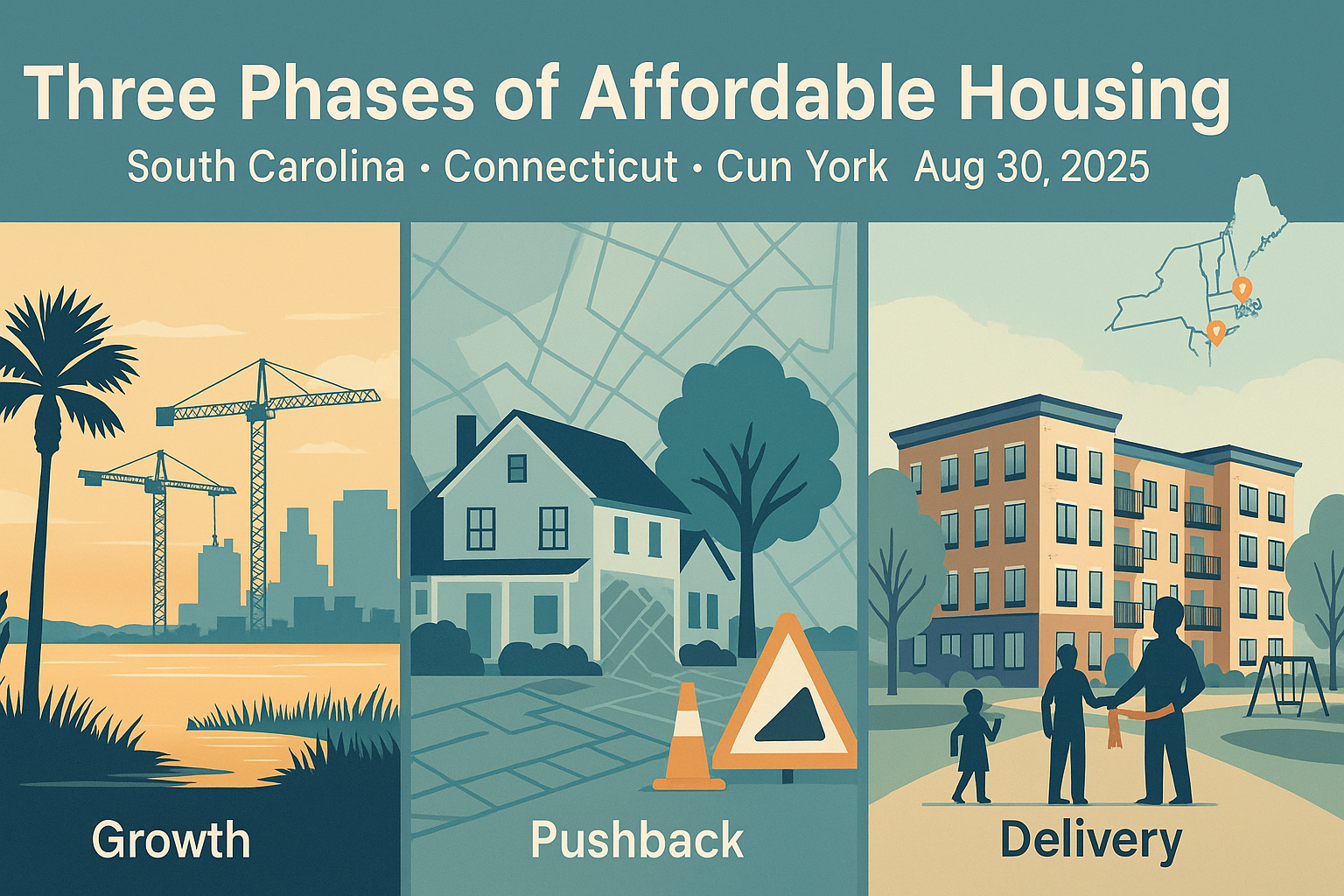Three Phases of Affordable Housing (Aug 30, 2025)
A week in housing and a weekend of recommendations
By Halina Bennet · · 1shot Production

This week offered a crisp snapshot of housing policy moving at three speeds: South Carolina racing to match rapid growth, Connecticut wrestling with local resistance vs. state reform, and New York delivering new income-restricted homes with a full financing stack. After the recap, you’ll find a practical toolkit of government programs and official links you can use right now.
1) South Carolina — Growth outpaces housing
- Fort Mill & high-growth metros: Multi-year population surges have tightened supply. Local leaders are using short, targeted pauses on annexations/rezonings to sync growth with capital planning.
- Charleston’s production plan: A multi-year roadmap to deliver thousands of affordable/attainable homes by 2031, with public-land activation, mixed-income deals, and nonprofit partnerships.
- State lens: Policymakers are discussing “concurrency”—linking new permits to infrastructure capacity (roads, utilities, schools)—to avoid backlog and service strain.
2) Connecticut — Local pushback meets statewide reform
- 8-30g friction: Even under the Affordable Housing Land Use Appeals Procedure, some proposals face denials or extended hearings over fire access, traffic, scale, or design.
- Capitol dynamics: A major 2025 reform bill was vetoed in June after concerns about state overreach into local zoning—setting up a continued debate as advocates, planners, and legislators regroup.
3) New York — Delivery keeps the pipeline credible
- Upstate milestone: A new 200-plus-unit, income-restricted community opened near a downtown core, with ~60% AMI targeting, supportive units, and family amenities.
- How it pencils: The capital stack blended Low-Income Housing Tax Credits (LIHTC), equity, energy grants, and local incentives—illustrating how deals close in high-cost contexts.
Government Programs You Can Use (with official links)
Use these as entry points. Most successful projects blend multiple tools (e.g., LIHTC + HOME/HTF + local incentives and public land).
Federal Production & Subsidy
- Low-Income Housing Tax Credit (LIHTC): The backbone of multifamily affordability finance. IRS overview
- HOME Investment Partnerships: Flexible gap financing for acquisition/new build/rehab. HUD HOME
- Community Development Block Grant (CDBG): Broad local funding; can support site work and rehab. HUD CDBG
- Housing Trust Fund (HTF): Deep affordability capital for extremely low-income renters. HUD HTF
- Housing Choice Vouchers (Section 8): Tenant-based rental subsidy via local PHAs. HUD HCV
Rural Tools (USDA Rural Development)
- Section 515/521: Rural rental production plus rental assistance. USDA Multifamily
- Section 502/504: Direct loans for homebuyers and repair grants/loans. USDA Single-Family
State Entry Points
- South Carolina: SC Housing (HFA) · SC Housing Trust Fund
- Connecticut: CT Department of Housing · CHFA (Tax Credits & Financing) · 8-30g Statute
- New York: NYS Homes & Community Renewal (HCR)
Actionable Next Steps (Weekend Picks)
- Small builders & nonprofits: Strengthen your capital-stack fluency and lender language with this approachable resource: SBA Free Webinar 2025: Your Guide to Securing Business Capital. Even if it’s framed for small businesses, the financing logic maps cleanly to scattered-site or infill housing deals.
- Personal stamina for policy work: Keep energy high during long permitting cycles and community meetings: Two Morning Habits for Better Energy.
Quick Glossary
- AMI: Area Median Income. Rents and eligibility are pegged to a % of AMI (e.g., 60% AMI).
- Concurrency: Requiring infrastructure capacity to “keep pace” with new development approvals.
- Supportive housing: Affordable units paired with on-site or linked services for residents who need them.
FAQ
What is Connecticut’s 8-30g?
It’s a state law that enables qualifying affordable-housing proposals to appeal local denials, limiting the grounds on which towns can reject them.
How does LIHTC finance actually work?
States allocate tax credits to projects. Developers sell those credits to investors for equity, reducing the amount of debt a property carries so it can offer lower rents.
Where do I apply for Housing Choice Vouchers?
Vouchers are administered locally by Public Housing Agencies (PHAs). Check your city or county PHA website for waitlist status and application windows.
Are USDA programs only for very small towns?
They’re intended for rural communities, but eligibility is based on federal maps and population thresholds—many micropolitan areas qualify. Always check your address.
What does 60% AMI mean for my rent?
Income limits and maximum rents are set by HUD each year. If your household income is at or below 60% AMI, you may qualify for certain income-restricted units.
Pingback: 5 Simple Steps to Apply for Medicaid & CHIP in the USA (2024 Guide) - trendbiteguide